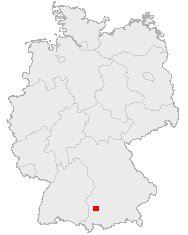- Landsberg-Lech Air Base
Infobox Airport
name = Landsberg-Lech Air Base
nativename = Flugplatz Penzing

IATA =
ICAO = ETSA
type = Military
owner = Unified Armed Forces of the Federal Republic of Germany
operator =Luftwaffe (German Air Force)
city-served =
location =Landsberg am Lech ,Germany
elevation-f = 2,044
elevation-m = 623
coordinates = coord|48|4|0|N|010|54|00|E|type:airport|display=inline
website =
metric-rwy = y
r1-number = 08/26
r1-length-f = 6,700
r1-length-m = 2,044
r1-surface =Asphalt
footnotes =Landsberg-Lech Air Base is a German Air Force base located near the town of
Landsberg am Lech inBavaria .Landsberg is used as a transport base. Aircraft at the base are Bo-105M, Transall C-160, and UH-1D helicopters.
History
World War II
With the re-establishment of the German Air Force (
Luftwaffe ) in 1935, locations for air bases were selected throughout the entire country. The Penzing area was selected for one of these bases because of the suitable geographical, navigational and other technical aspects. Land was procured in 1935 and by spring of 1936 the construction of Landsberg Air Base was well underway. A small detachment of airmen arrived on10 February 1937 and a full complement had arrived by1 March . The Luftwaffe unit was designated Combat Wing 255.The first assigned aircraft were Dornier 17E and 17M bombers. On
1 August 1939 the Do-17s were replaced by the Heinkel 111, and the unit was designated as Combat Wing 51. DuringWorld War II , this unit saw combat on all war fronts. Landsberg, meanwhile, was utilized primarily for pre-flying and general training.Late in the war, two attacks by American
B-17 Flying Fortress bombers knocked out three of the base's hangars, all the runways, and damaged many of the grounded aircraft. Toward the waning days of the war, most of Germany's best radar technicians were sent to Landsberg Air Base.In 1945, a U.S. Armored Division swept into the area. On
28 April the base was occupied.USAF Use
Company "C" of the Army's 843rd Engineer Aviation Battalion arrived on
17 May to rehabilitate the base. A high priority was assigned to runway repair - to make the airfield operational. With the runway project completed, an Air Depot Group moved in and began repairing buildings for living quarters, mess facilities and so forth. The personnel moved from their tents into rebuilt quarters as they were completed. In January 1946 the 862nd Engineer Battalion arrived to complete the repair of bombed out facilities.In 1947 the USAF 7280th Air Base Group was established at Landsberg as a detached unit of
Erding Air Base . In 1949, the base was designated as Landsberg Air Base and placed under the command of the2d Air Division . On1 May 1950 the base support unit was designated the 7030th Headquarters Support Group.During the
Cold War , it was aUnited States Air Force base.USAF Units stationed at Landsberg were:
* 1949-1951: HQ,
2d Air Division
* 1955-1958: 7351st Fighter Training WingTraining The Luftwaffe
The 7351st Air Base Squadron was activated in January 1953, and assumed control of Landsberg as the host unit on
1 July . On1 April 1955 the 7351st Flying Training Group (MDAP) was activated to prepare Landsberg as a pilot training center. The group was further expanded and was designated the 7351st Flying Training Wing (MDAP) on1 October 1955 The wing consisted of three groups, with a total of seven squadrons.Having joined NATO in 1955, West Germany could begin to re-establish the Luftwaffe. Work soon started on the construction of airfields and training grounds and possibilities for training German pilots were investigated.
Landsberg Air Base was selected as the site for the retraining of the German Air Force. The first flight with American instructors took place on
4 February 1956 . There were still manyWorld War II veterans who could, however, only fly propeller aircraft. They had not seen operational service for ten years and had absolutely no experience with supersonic jet fighters.The modern jets were not complete strangers to the former German officers, however. For more than two years it had already been quite usual for former Luftwaffe pilots to make familiarization flights on USAF jet fighters.
The new Luftwaffe began building up basic pilot training using forty Piper L-18A Super Cub trainers. Advanced training and jet transition was looked after by the USAF at
Fürstenfeldbruck Air Base where the Luftwaffe could use several new Lockheed T-33A T-Bird jet-trainers.The first ten German jet fighter pilots trained by USAFE instructors received their 'wings' on
24 September 1956 . Future German F-86 pilots were also trained atNellis AFB inNevada .Training continued until 1958 when the 7351st FTG was deactivated and Landsburg turned over to the German Air Force. Within several years the new Luftwaffe would acquire hundreds of
F-86 Sabre s and F-84F Thunderstreaks via the American MDAP aid programme so training had to be taken in hand very quickly.ee also
*
German Air Force
*United States Air Force In Germany References
* Endicott, Judy G. (1999) Active Air Force wings as of 1 October 1995; USAF active flying, space, and missile squadrons as of 1 October 1995. Maxwell AFB, Alabama: Office of Air Force History. CD-ROM.
* Maurer, Maurer (1983). Air Force Combat Units Of World War II. Maxwell AFB, Alabama: Office of Air Force History. ISBN 0892010924.
* Ravenstein, Charles A. (1984). Air Force Combat Wings Lineage and Honors Histories 1947-1977. Maxwell AFB, Alabama: Office of Air Force History. ISBN 0912799129.
* USAAS-USAAC-USAAF-USAF Aircraft Serial Numbers--1908 to Present [http://home.att.net/~jbaugher/usafserials.html]External links
* [http://www.furstytreemovers-landsbergbavarians.org/history_of_landsberg.htm History of Landsberg Air Base]
Wikimedia Foundation. 2010.
